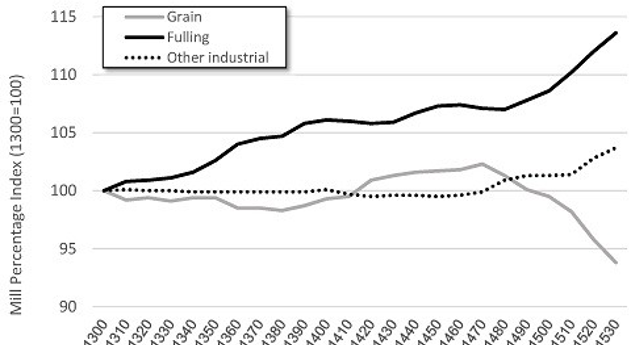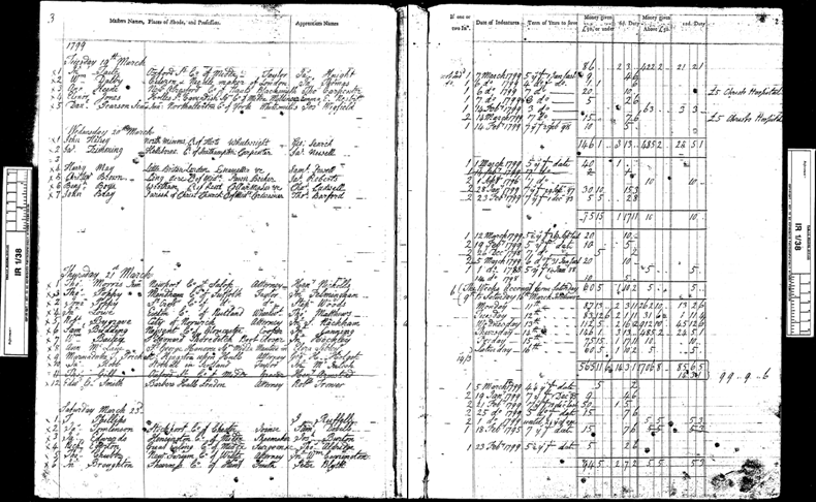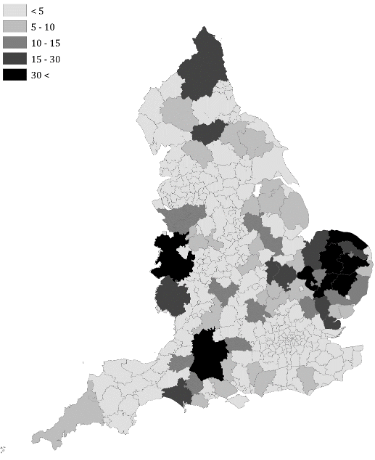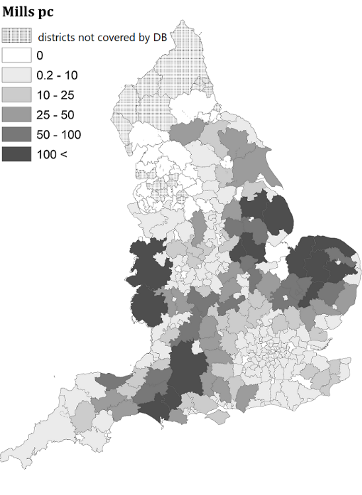Policymakers’ ongoing concerns with the supply of skilled personnel necessary for keeping pace with technological change stem from the notion that both technological advancement and technological catch-up depend strongly on the availability of human capital.
This was first argued more than 50 years ago by Nelson and Phelps (1966), and has been widely accepted by economists since. But the empirical evidence is ambiguous. Some studies point to differences in schooling and school attendance as central to the explanation of differences in economic performance (Glaeser et al. 2004). But others argue huge investments in education have had little or no effect on economic growth (Easterly 2001, Pritchett 2001).
When economic historians debate the role of human capital in the British Industrial Revolution, the consensus is that British leadership during the Industrial Revolution owed little to the school system, and that literacy rates in England were mediocre compared to other European nations (Mitch 1992, 1999).
Recent work on human capital suggests that we should rethink this consensus on the role of human capital (Mokyr 2009). This suggests that the content of education mattered as much – or more – than the quantity of education, as expressed in years of schooling. It stresses that the quality and competence of workers in the top few percent of the distribution mattered more to technological advances than the capabilities of the average worker. This is becoming known as 'upper-tail human capital' (e.g. in Squicciarini and Voigtlaender 2016).
According to this view, innovation and technological leadership in the early stages of the British Industrial Revolution depended on a supply of top-quality artisanal skills, as well as on high-calibre inventors such as James Watt (1738—1819) or Richard Roberts (1789—1864). Cookson (2018) has pointed out that “[t]here was a limit to how many James Watts could be accommodated in a business." She argued that the real need was for “skilled workers with shopfloor duties.”
By focusing on a particular occupational group of high-quality mechanics in England referred to as 'wrights' (or more specifically, millwrights), we have found empirical support for this view (Mokyr et al. 2019). Millwrights were highly-skilled carpenters who specialised in constructing and repairing watermills. This group, which evolved with the adoption of watermills for grain grinding in the early middle ages, had a persistent effect on the mechanisation of textile- and iron-making – major industries at the time – and on the economic expansion that was taking place on the eve of the Industrial Revolution in the middle of the 18th century.
The evolution of mechanical human capital and its persistent effect
Our hypothesis is that the availability of wrights, once in place, generated a positive spillover effect for the adoption of water-power technology to other industrial uses in England. These included fulling mills in textiles, blowing mills in tin smelting, water-raising mills in mines, and forging mills in iron-works. This relationship was most pronounced in the textile sector, in which fulling mills were widely adopted by the beginning of the 14th century (Figure 1).
Figure 1 Percentage index of industrial mills vs grain mills, 1300 – 1540 (100 = 1300)
Source: Langdon (2004), Table 2.2.
The technical competence of wrights in the construction, maintenance, and improvement of the machinery, their numbers grew alongside the technological changes that took place in the textile sector during the first half of the 18th century (Feldman and van der Beek 2016). This process continued at least until the closing decades of the 18th century, at which time steam engines began to replace the waterwheel as a source of energy and engineering became the demanded skill. Our hypothesis is that the adoption of grinding mills was important, not only as a source of motive energy, but also as a stimulus to skill accumulation and a focusing device for innovation.
Historical district-level data
To estimate the causal effect of the availability of mechanical skills on textile production, and on other industries, between 1710 and 1750, we constructed a cross-section dataset of England's government districts. The first empirical challenge was to acquire systematic data about occupations and production factors corresponding to periods when this data is not readily available.
We used information on apprentices to masters in different trades from The Apprenticeship Stamp Tax registers between 1710 and 1805 (Figure 2) to approximate the size of various skilled occupational groups and industrial sectors.1
Figure 2 Exemplary pages from the Apprenticeship Stamp Tax Registers: 1710–1805
Source: UK National Archives.
The maps in Figures 3 and 4 show the approximate distribution of textile production and of wrights. Occupational variables were all measured per capita.
Figure 3 Apprentices to drapers, 1710-50
Source: UK National Archives.
Note: Apprentice numbers are per 1,000 population. 'Drapers' defined as masters described as drapers, clothiers, or cloth merchants.
Figure 4 Apprentices to wrights 1710-50
Source: UK National Archives.
Note: Apprentice numbers are per 1,000 population. 'Wrights' defined as apprentices to masters referred to as mill carpenter, millwright, wheelwright, or simply, wright.
Establishing a causal relationship between the availability of wrights and economic expansion
The empirical challenge was to establish a causal relationship between human capital and industrial production. Wrights specialised in all types of machinery including textile fulling mills, and their number in the 18th century may have also been a response to the expansion in textile production, not just its cause. So we used the location of watermills in the Domesday Book, compiled in 1086, as an external source of variation in the location of wrights (see Figure 5).
Figure 5 The Domesday Book mills per capita, 1086
Source: Palmer (2010).
Domesday mills were used for grain grinding at the time, and therefore wrights, who specialised in their mechanics and so resided in areas with high concentrations of mills, were available in these areas long before mills were adapted to other uses. Thus, any variation in the location of wrights in the eighteenth century that is explained by the variation in the location of mills at the time of Domesday Book would be independent of textile production.
To exclude the possibility that the location of Domesday mills was biased by an omitted unobservable characteristic of the district, we also used a geographical instrument constructed to capture the suitability of a district for the construction of grain watermills. We used the interaction between the length of rivers in the district that have moderate levels of ruggedness with districts that were highly suitable for wheat cultivation, and so had a larger need for mills. We also accounted for other factors that may have also affected textile production, such as differences in a wide range of geographical conditions, as well as economic factors such as agricultural suitability, the distance from London, and distance from the main English ports at the beginning of the 18th century.
Findings
Using the number of drapers as a proxy for the size of the textile industry in each location, there is a positive economically and statistically significant association between the number of draper apprentices per capita and wright apprentices per capita. This suggests that an increase in the number of wrights per capita by one is associated with an increase of 0.38 draper apprentices. Figure 6 depicts the partial correlation between draper apprentices and wright apprentices that was captured in this analysis. Note that the results do not rely on any outlier.
Figure 6 Partial correlation between numbers of drapers per capita and wrights per capita, 1710-50
The estimations that use Domesday Book mills as an instrument for the location of wrights result in a higher estimate than the OLS estimator, and are economically and statistically significant. Controlling for potentially confounding effects, an additional wright generates an average increase of 0.55 drapers in a district. Using the geographical instrument, the increase of one wright apprentice per capita in a district generates an increase of 0.73 draper apprentices per capita. Replicating our result to the iron-making industry provides similar results.
The results are also robust to spatial autocorrelation, the availability of coal, biases due to the choice of occupations, reliance on specific levels of wheat suitability or ruggedness of rivers, and bias due to the effect of London. We also performed two placebo tests to make sure that our results do not hold for other, non-relevant occupations.
So economically significant upper-tail human capital, such as local mechanical competence, tended to persist over time and helped determine the location of textile industries in the 18th century. The geographical conditions that favoured the construction of water mills for grain-milling created a class of highly trained millwrights. The 19th-century Scottish engineer William Fairbairn reflected that:
“The millwright of former days was to a great extent the sole representative of mechanical art ... a kind of jack of all trades who could with equal facility work at a lathe, the anvil, or the carpenter’s bench... a fair arithmetician who could calculate the velocities, strength and power of machines...” (Fairbairn, 1871, p. ix-x).
These skills spilled over from grain-milling to the wool industry, and in this way millwrights played a role in England becoming an industrial nation.
References
Board of Stamps (1710-1805), Apprenticeship Books, Series IR 1, The National Archives of the UK.
Cookson, G (2018), The Age of Machinery: Engineering in the Industrial Revolution, 1770-1850, Boydell and Brewer.
Darby H C, ed. (1973), A New Historical Geography of England, Cambridge University Press.
Easterly, W (2001), The Elusive Quest for Growth, MIT Press.
Fairbairn, W (1871), Treatise on Mills and Millwork Vol. 1. 3rd edition, Longmans, Green and Co.
Feldman, N E, and van der Beek, K (2016), “Skill Choice and Skill Complementarity in Eighteenth Century England”, Explorations in Economic History 59: 94-113.
Glaeser, E L, R La Porta, F Lopez-de-Silanes, A Shleifer (2004), “Do institutions cause growth?”, Journal of Economic Growth 9: 271–303.
Langdon, J (2004), Mills in the Medieval Economy: England 1300-1540, Oxford University Press.
Mokyr, J (2009), The Enlightened Economy: An Economic History of Britain 1700-1850, Yale University Press.
Mokyr J, A Sarid, and K van der Beek (2019), “The Wheels of Change: Human Capital, Millwrights, and Industrialization in Eighteenth-Century England”, CEPR discussion paper 14138.
Nelson, R R, and Phelps, E S (1966), “Investment in Humans, Technological Diffusion, and Economic Growth", American Economic Review 56(1/2): 69-75.
Palmer, J (2010), Electronic Edition of Domesday Book: Translation, Databases and Scholarly Commentary, 1086, 2nd Edition, UK Data Service.
Pritchett, L (2001), “Where Has All the Education Gone?”, World Bank Economic Review 15(3): 367-391.
Squicciarini, M and N Voigtländer (2015), “Human Capital and Industrialization: Evidence from the Age of Enlightenment”, Quarterly Journal of Economics 30: 1825–1883.
Endnotes
[1] The entries in these registers represent indentures (apprenticeship contracts under which masters agreed to instruct their trade for a set term of years – usually seven – in exchange for a sum of money called a premium) and contain information on masters’ trade, location and on the premium paid. The entries begin in 1710, following the introduction of a stamp duty payment on apprenticeship contracts. Indentures were void without the stamp.











